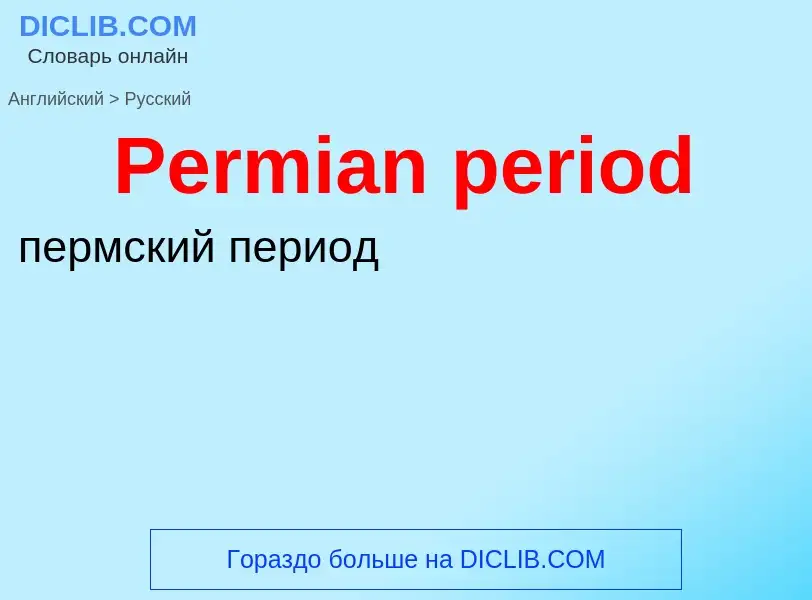Translation and analysis of words by ChatGPT artificial intelligence
On this page you can get a detailed analysis of a word or phrase, produced by the best artificial intelligence technology to date:
- how the word is used
- frequency of use
- it is used more often in oral or written speech
- word translation options
- usage examples (several phrases with translation)
- etymology
Permian period - translation to russian
['pə:miən]
прилагательное
геология
пермский
Definition
Wikipedia
The Permian ( PUR-mee-ən) is a geologic period and stratigraphic system which spans 47 million years from the end of the Carboniferous Period 298.9 million years ago (Mya), to the beginning of the Triassic Period 251.9 Mya. It is the last period of the Paleozoic Era; the following Triassic Period belongs to the Mesozoic Era. The concept of the Permian was introduced in 1841 by geologist Sir Roderick Murchison, who named it after the region of Perm in Russia.
The Permian witnessed the diversification of the two groups of amniotes, the synapsids and the sauropsids (reptiles). The world at the time was dominated by the supercontinent Pangaea, which had formed due to the collision of Euramerica and Gondwana during the Carboniferous. Pangaea was surrounded by the superocean Panthalassa. The Carboniferous rainforest collapse left behind vast regions of desert within the continental interior. Amniotes, which could better cope with these drier conditions, rose to dominance in place of their amphibian ancestors.
Various authors recognise at least three, and possibly four extinction events in the Permian. The end of the Early Permian (Cisuralian) saw a major faunal turnover, with most lineages of primitive "pelycosaur" synapsids becoming extinct, being replaced by more advanced therapsids. The end of the Capitanian Stage of the Permian was marked by the major Capitanian mass extinction event, associated with the eruption of the Emeishan Traps. The Permian (along with the Paleozoic) ended with the Permian–Triassic extinction event, the largest mass extinction in Earth's history (which is the last of the three or four crises that occurred in the Permian), in which nearly 81% of marine species and 70% of terrestrial species died out, associated with the eruption of the Siberian Traps. It took well into the Triassic for life to recover from this catastrophe; on land, ecosystems took 30 million years to recover.


![[[Life reconstruction]] of Permian [[wetland]] environment, showing a [[Eryops]] [[Life reconstruction]] of Permian [[wetland]] environment, showing a [[Eryops]]](https://commons.wikimedia.org/wiki/Special:FilePath/Diorama of a Permian forest floor - Eryops (45651934102).jpg?width=200)
![''[[Hercosestria]] cribrosa'', a [[reef]]-forming productid brachiopod (Middle Permian, Glass Mountains, Texas) ''[[Hercosestria]] cribrosa'', a [[reef]]-forming productid brachiopod (Middle Permian, Glass Mountains, Texas)](https://commons.wikimedia.org/wiki/Special:FilePath/HercosestriaPair040111.jpg?width=200)
![permocupedid]] beetle from the Middle Permian of Russia permocupedid]] beetle from the Middle Permian of Russia](https://commons.wikimedia.org/wiki/Special:FilePath/Permocupes sojanensis holotype and reconstruction.jpg?width=200)
![weigeltisaurid]] from the Late Permian of Europe. Weigeltisaurids represent the oldest known gliding vertebrates. weigeltisaurid]] from the Late Permian of Europe. Weigeltisaurids represent the oldest known gliding vertebrates.](https://commons.wikimedia.org/wiki/Special:FilePath/Weigeltisaurus reconstruction.png?width=200)
![Edaphosaurus pogonias]]'' and ''[[Platyhystrix]]'' – Early Permian, North America and Europe Edaphosaurus pogonias]]'' and ''[[Platyhystrix]]'' – Early Permian, North America and Europe](https://commons.wikimedia.org/wiki/Special:FilePath/EdaphosaurusDB.jpg?width=200)
![Dimetrodon grandis]]'' and ''[[Eryops]]'' – Early Permian, North America Dimetrodon grandis]]'' and ''[[Eryops]]'' – Early Permian, North America](https://commons.wikimedia.org/wiki/Special:FilePath/Dimetr eryopsDB.jpg?width=200)
![Estemmenosuchus uralensis]]'' and ''[[Eotitanosuchus]]'' – Middle Permian, Ural Region Estemmenosuchus uralensis]]'' and ''[[Eotitanosuchus]]'' – Middle Permian, Ural Region](https://commons.wikimedia.org/wiki/Special:FilePath/Ocher fauna DB.jpg?width=200)
![''[[Titanophoneus]]'' and ''[[Ulemosaurus]]'' – Ural Region ''[[Titanophoneus]]'' and ''[[Ulemosaurus]]'' – Ural Region](https://commons.wikimedia.org/wiki/Special:FilePath/Titanophoneus 3.jpg?width=200)
![Inostrancevia alexandri]]'' and ''[[Scutosaurus]]'' – Late Permian, North European Russia (Northern Dvina) Inostrancevia alexandri]]'' and ''[[Scutosaurus]]'' – Late Permian, North European Russia (Northern Dvina)](https://commons.wikimedia.org/wiki/Special:FilePath/Inostrancevia 4DB.jpg?width=200)
